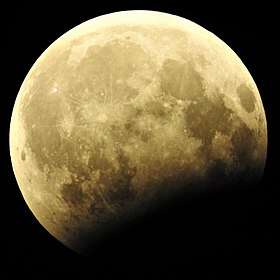August 1971 lunar eclipse
A total lunar eclipse took place on August 6, 1971. The moon passed through the center of the Earth's shadow.
| Total Lunar Eclipse August 6, 1971 | |
|---|---|
| (No photo) | |
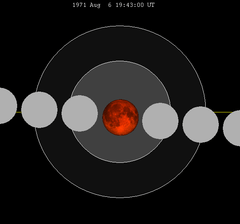 The moon passes west to east (right to left) across the Earth's umbral shadow, shown in hourly intervals. | |
| Series | 128 (38 of 71) |
| Duration (hr:mn:sc) | |
| Totality | |
| Partial | |
| Penumbral | |
| Contacts | |
| P1 | UTC |
| U1 | |
| U2 | |
| Greatest | |
| U3 | |
| U4 | |
| P4 | |
Visibility
It was completely visible over Africa and Asia, rising over South America, and setting over Australia.
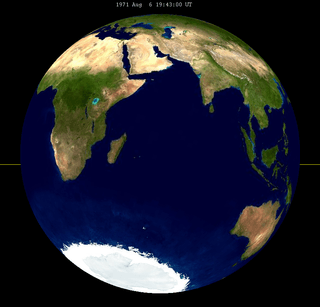
Relation to other lunar eclipses
Lunar year series
| Ascending node | Descending node | |||||
|---|---|---|---|---|---|---|
| Saros | Date Viewing |
Type Chart |
Saros | Date Viewing |
Type Chart | |
| 108 | 1969 Aug 27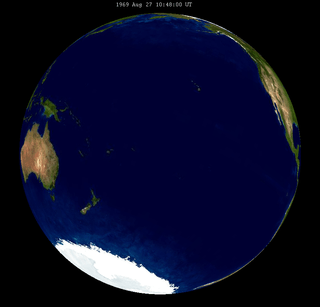 |
Penumbral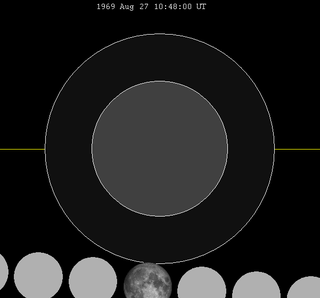 |
113 | 1970 Feb 21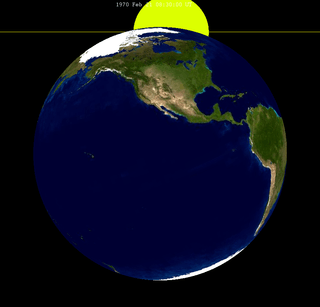 |
Partial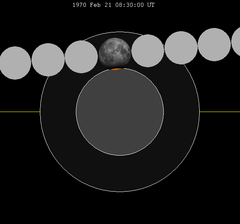 | |
| 118 | 1970 Aug 17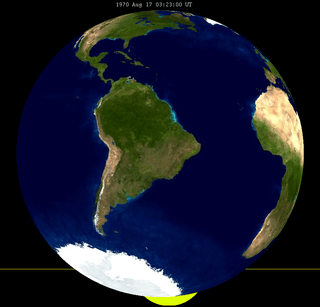 |
Partial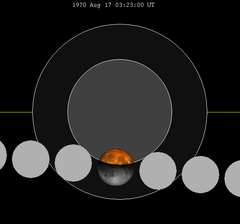 |
123 | 1971 Feb 10 |
Total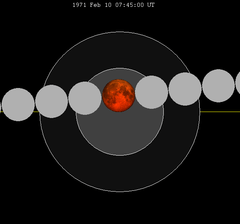 | |
| 128 | 1971 Aug 6 |
Total |
133 | 1972 Jan 30 |
Total | |
| 138 | 1972 Jul 26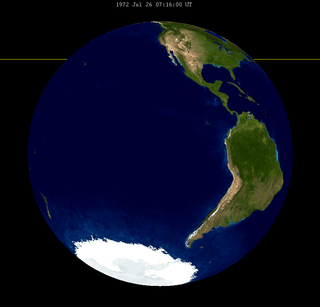 |
Partial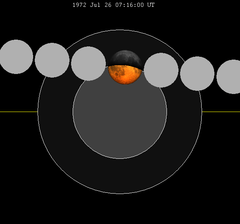 |
143 | 1973 Jan 18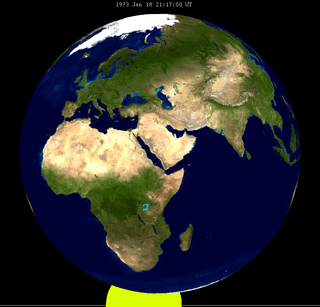 |
Penumbral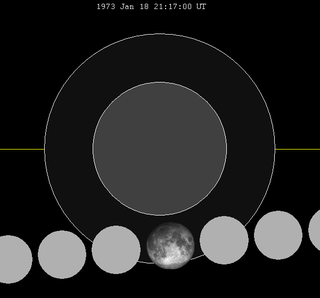 | |
| 148 | 1973 Jul 15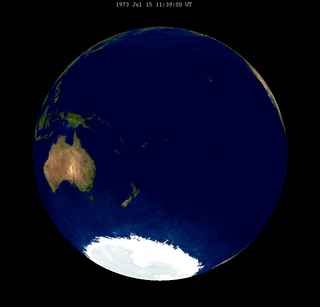 |
Penumbral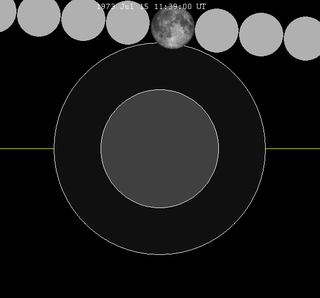 | ||||
| Last set | 1969 Sep 25 | Last set | 1969 Apr 2 | |||
| Next set | 1973 Jun 15 | Next set | 1973 Dec 10 | |||
Saros series
Lunar saros series 128, repeating every 18 years and 11 days, has a total of 71 lunar eclipse events including 57 umbral eclipses (42 partial lunar eclipses and 15 total lunar eclipses). Solar Saros 135 interleaves with this lunar saros with an event occurring every 9 years 5 days alternating between each saros series.
| Greatest | First | |||
|---|---|---|---|---|
 The greatest eclipse of the series occurred on 1953 Jul 26, lasting 108 minutes.[1] |
Penumbral | Partial | Total | Central |
| 1304 Jun 18 | 1430 Sep 2 | 1845 May 21 | 1899 Jun 23 | |
| Last | ||||
| Central | Total | Partial | Penumbral | |
| 2007 Aug 28 | 2097 May 21 | 2440 May 17 | 2566 Aug 2 | |
| 1917 Jul 4 | 1935 Jul 16 | 1953 Jul 26 | |||
 |
 |
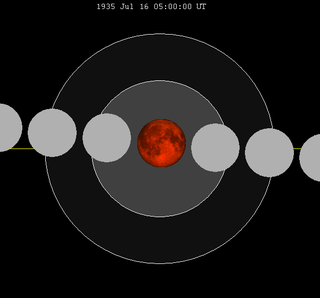 |
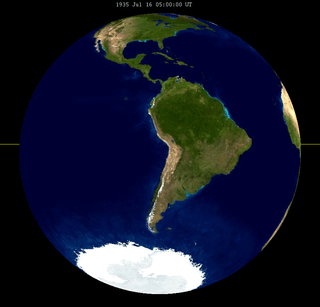 |
 |
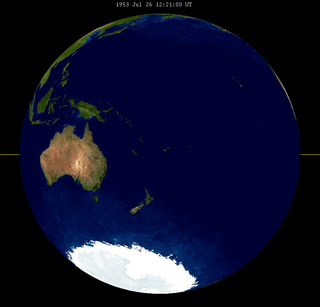 |
| 1971 Aug 6 | 1989 Aug 17 | 2007 Aug 28 | |||
 |
 |
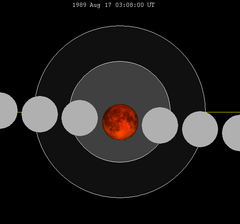 |
 |
 |
 |
| 2025 Sep 7 | 2043 Sep 19 | 2061 Sep 29 | |||
 |
 |
 |
 |
 |
 |
| 2079 Oct 10 | 2097 Oct 21 | ||||
 |
 |
 |
 | ||
Lunar Saros 128 contains 15 total lunar eclipses between 1845 and 2097 (in years 1845, 1867, 1881, 1899, 1917, 1935, 1953, 1971, 1989, 2007, 2025, 2043, 2061, 2079 and 2097). Solar Saros 135 interleaves with this lunar saros with an event occurring every 9 years 5 days alternating between each saros series.
Inex series
The inex series repeats eclipses 20 days short of 29 years, repeating on average every 10571.95 days. This period is equal to 358 lunations (synodic months) and 388.5 draconic months. Saros series increment by one on successive Inex events and repeat at alternate ascending and descending lunar nodes.
This period is 383.6734 anomalistic months (the period of the Moon's elliptical orbital precession). Despite the average 0.05 time-of-day shift between subsequent events, the variation of the Moon in its elliptical orbit at each event causes the actual eclipse time to vary significantly. It is a part of Lunar Inex series 40.
All events in this series shown (from 1000 to 2500 and beyond) are central total lunar eclipses.
| Descending node | Ascending node | Descending node | Ascending node | ||||
|---|---|---|---|---|---|---|---|
| Saros | Date | Saros | Date | Saros | Date | Saros | Date |
| 95 | 1016 May 24 | 96 | 1045 May 3 | 97 | 1074 Apr 14 | 98 | 1103 Mar 25 |
| 99 | 1132 Mar 3 | 100 | 1161 Feb 12 | 101 | 1190 Jan 23 | 102 | 1219 Jan 2 |
| 103 | 1247 Dec 13 | 104 | 1276 Nov 23 | 105 | 1305 Nov 2 | 106 | 1334 Oct 13 |
| 107 | 1363 Sep 23 | 108 | 1392 Sep 2 | 109 | 1421 Aug 13 | 110 | 1450 Jul 24 |
| 111 | 1479 Jul 4 | 112 | 1508 Jun 13 |
113 | 1537 May 24 | 114 | 1566 May 4 |
| 115 | 1595 Apr 24 | 116 | 1624 Apr 3 | 117 | 1653 Mar 14 | 118 | 1682 Feb 21 |
| 119 | 1711 Feb 3 | 120 | 1740 Jan 13 | 121 | 1768 Dec 23 | 122 | 1797 Dec 4 |
| 123 | 1826 Nov 14 | 124 | 1855 Oct 25 | 125 | 1884 Oct 4 | 126 | 1913 Sep 15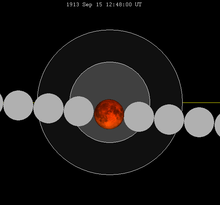 |
| 127 | 1942 Aug 26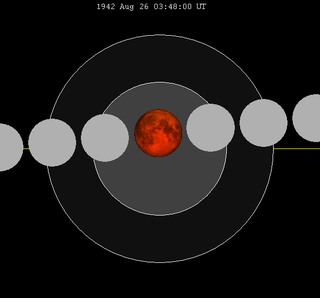 |
128 | 1971 Aug 6 |
129 | 2000 Jul 16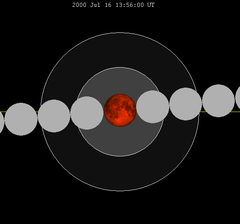 |
130 | 2029 Jun 26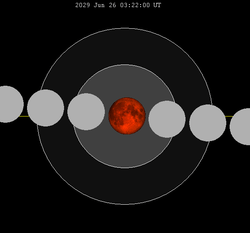 |
| 131 | 2058 Jun 6 |
132 | 2087 May 17 |
133 | 2116 Apr 27 | 134 | 2145 Apr 7 |
| 135 | 2174 Mar 18 | 136 | 2203 Feb 26 | 137 | 2232 Feb 7 | 138 | 2261 Jan 17 |
| 139 | 2289 Dec 27 | 140 | 2318 Dec 9 | 141 | 2347 Nov 19 | 142 | 2376 Oct 28 |
| 143 | 2405 Oct 8 | 144 | 2434 Sep 18 | 145 | 2463 Aug 29 | 146 | 2492 Aug 8 |
Half-Saros cycle
A lunar eclipse will be preceded and followed by solar eclipses by 9 years and 5.5 days (a half saros).[2] This lunar eclipse is related to two annular solar eclipses of Solar Saros 135.
| July 31, 1962 | August 10, 1980 |
|---|---|
 |
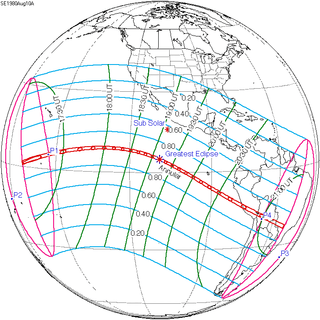 |
See also
- List of lunar eclipses
- List of 20th-century lunar eclipses
Notes
- Listing of Eclipses of cycle 128
- Mathematical Astronomy Morsels, Jean Meeus, p.110, Chapter 18, The half-saros
